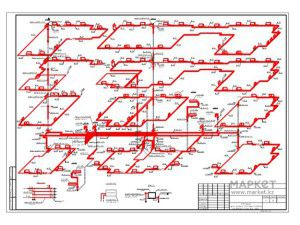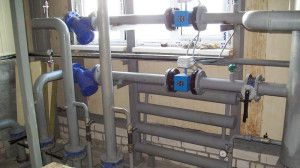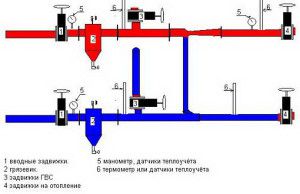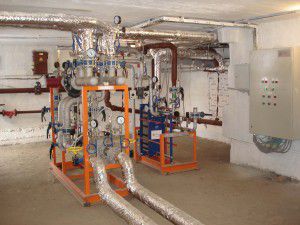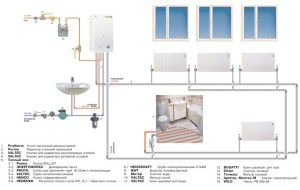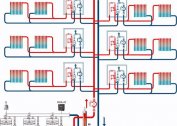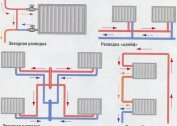What is the difference between heating an apartment building from a similar autonomous system of a private cottage or cottage? First of all, by the presence of a complex layout of piping and heating radiators. In addition to this, the system includes unique control and safety devices. Let us consider in more detail what characterizes the heating of residential buildings: norms, standards, calculation and flushing.
General regulatory documents for heating
To design the heating of an apartment building, you need to know the current standards. They are detailed in the relevant documents - GOST, SNiPah. Without them, the commissioning of any residential building is impossible.
There are certain standards for heating residential premises, which you must know when designing a heat supply. They indicate critical temperature levels in residential premises, determine errors depending on weather conditions and time of day. The determining documents for the organization of heating of residential buildings are:
- SNiP 2301-99. It describes the level of air heating in apartments, residential and non-residential premises;
- SNiP 4101-2003. Information on ventilation and heat supply standards depending on the type of building;
- SNiP 2302-2003. Data on the required degree of thermal insulation are indicated. Without this information, it is impossible to correctly calculate the heating of a residential building;
- SNiP 4102-2003. Standards and requirements for central heating.
In addition to these documents, it is necessary to take into account the contents of others that relate to specific heating devices. In particular, installation and connection of gas equipment, organization of a boiler room, etc.
But for consumers it is important to know the parameters that the heating system of an apartment building should have. Summarizing all the requirements from the above documents, we can distinguish the main characteristics of the heat supply of residential buildings.
| Type of premises | Optimum temperature, ° С | Critical temperature, ° С |
| Living room | 20-22 | 18-24 |
| Kitchen and toilet | 19-21 | 18-26 |
| Bathroom | 24-26 | 18-26 |
| Corridor interroom | 18-20 | 16-22 |
| Staircase, pantries | 16-18 | 14-20 |
Most often, heating of stairwells in residential buildings suffers. In them, due to large heat losses, the temperature in the winter period is almost always below normal. Therefore, the residents of the house have the right to complain to the management company to rectify the situation.
Carrying out control measurements of temperature in the premises must be carried out by representatives of the Criminal Code at the first appeal of the residents of the house.
Types of heat supply for apartment buildings
Despite the fact that heating and cooling of residential premises are essentially different systems in modern houses, they can be combined into a single complex. However, at present it is still a rarity, since the heat supply of most houses is carried out according to old technologies.
Most common is water heating, as one of the most adapted to various types of buildings - residential, administrative and industrial. When designing it, you need to consider such features:
- Coolant cooling rate. For a single-pipe system, the degree of heating of radiators located in the last sections of the circuit will be significantly lower than in the first;
- Hydraulic resistance. The more complicated the line, the greater the resistance that hot water encounters when passing through pipes. Therefore, a powerful pumping station is needed to create circulation.
- Operational properties of water, pipes and radiators. In particular, it is necessary to flush the heating system of a residential building in order to maintain the current heat supply parameters.
Until recently, the only option for organizing heating was a centralized hot water distribution system. She remains the same to this day.
To reduce the degree of heating of the radiators, temperature regulators are installed. In single pipe systems, bypasses are additionally mounted.
Central heating of a building
The essence of the central distribution of the coolant in several houses is to create a scheme: boiler-distribution nodes-consumers. It is important for her to take into account the described standards for heating residential premises, since there is a high probability of heat loss during the passage of hot water through communications.
For such heating of an apartment building, both advantages and disadvantages are characteristic. Last, alas, more. Therefore, they try to switch to individual heat supply schemes. But to do this is currently problematic due to difficulties at the legislative level.
Analyzing the centralized heating of residential buildings, one can identify a number of operating features:
- The consumer cannot directly influence the degree of water heating. The maximum that he can do is to reduce its influx into a specific radiator;
- Difficulties in the installation of heat meters. Each apartment can have from 2 to 5 distribution risers, on which it is necessary to install meters;
- Dates of turning on and off heating and cooling of residential premises. In practice, they are independent of current weather conditions.
It must be borne in mind that for high-quality heating of stairwells in residential buildings, it is necessary to ensure the proper level of thermal insulation. Responsible Housing Office or similar organization is responsible for this. Therefore, to create a truly effective heat supply in an apartment building, sometimes residents have to make a lot of effort.
An alternative to heat meters in each apartment is the installation of a common house heat energy meter.
Autonomous heat supply at home
Is it possible to do the heating of a residential building with your own hands? At first glance, this task is difficult. This is especially true of buildings of the old type, in which the project documentation provides for district heating.
However, the situation is gradually changing and the individual heating system of a residential building is no longer a rarity. It differs from the traditional one in a large selection of heating methods, lower energy costs and the ability to turn on / off, depending on external factors.
When designing such systems, residential heating standards, which were mentioned above, are taken into account. This is necessary when putting the house into operation. Also, following these standards gives a guarantee of creating comfortable living conditions for residents of the house.
There are several options for heating an apartment house with your own hands:
- Water heat supply. Gas, electric or solid fuel boilers can serve as a source of water heating. The latter are rarely used in the individual heating system of a residential building, since they need to equip a separate boiler room;
- Aerial. It is combined with heating and cooling of residential apartments and premises. This requires a special climate system, which is connected to the duct system. One of the best options for industrial premises;
- Steam. It is used extremely rarely in heating systems of an apartment building. Despite the expensive equipment, its efficiency is one of the highest among those considered.
However, it is necessary to choose the right scheme for flushing the heating system of a residential building.If in the centralized it is carried out mainly by the hydrodynamic method, then in this case the chemical can also be used. An important point is the safety of the effects of chemicals on heating components - pipes and radiators.
In order to save money in the autonomous heating of an apartment building, the installation of a heat accumulator is recommended. Be sure to pre-calculate its capacity.
Independent heating of the apartment
Is it possible to make not only heating an apartment building independently, but also a single apartment? To do this, you must obtain permission from the city authorities and organizations of the city’s architecture.
The main catch in organizing an individual heating system for a residential building is its adaptation to the technical conditions. Most often they switch to individual gas heat supply. This entails an additional load on the ventilation ducts of the house, which is not always acceptable by the operating standards.
After agreeing on these issues, you can begin to plan the heating of the living space. It consists in solving the following tasks:
- Calculation of the characteristics of heating a living room. This includes the calculation of heat loss, the required power of the equipment.
- Based on the data obtained, the selection of components and system components is performed.
- Installation. After the installation of heat supply, its work should not affect the general heating system of an apartment building.
Subsequent maintenance and repair of heat supply is the problem of the owner of the apartment. At any time, representatives of government agencies can check the system for its compliance with regulations. Therefore, the whole scheme must meet the standards and norms. All documentation (design and technical) should be kept at home. It is advisable to make copies in advance for submission to reviewers.
Flushing the heating system of a residential building or apartment must be carried out at least 1 time in 3 years. The methods can be different - hydraulic, pneumatic or chemical.
Calculation of the characteristics of the apartment heating system
The most important step in the planning of heat supply is the calculation of its basic technical and operational characteristics. To do this, you should perform a professional calculation of heating a residential apartment or building. It consists of the following steps:
- Calculation of heat loss through the walls and windows of the apartment. It is necessary to take into account the operation of the ventilation system if it does not have the function of heating the air.
- Determination of the optimal power of the heating equipment — the boiler and the heat output of the radiators.
- Drawing up a temperature schedule according to residential heating standards. This will help determine the maximum and minimum load on the system depending on the outdoor temperature.
You can perform these calculations yourself, or using specialized software systems. The latter option is preferable, since the accuracy of the calculation in this case will be quite high. It is important to initially set the initial parameters correctly - the material of the walls, the number of storeys of the apartment, the climate region, etc.
What else do you need to know about autonomous heating of an apartment to plan it? An important task is to minimize the cost of its operation. This requires the installation of control equipment - programmers and temperature controllers. With their help, you can reduce current costs. This is especially important for an electric heating boiler. It is necessary to install a two-tariff electricity meter for it.
The video shows an example of the organization of autonomous heating in an apartment building.
